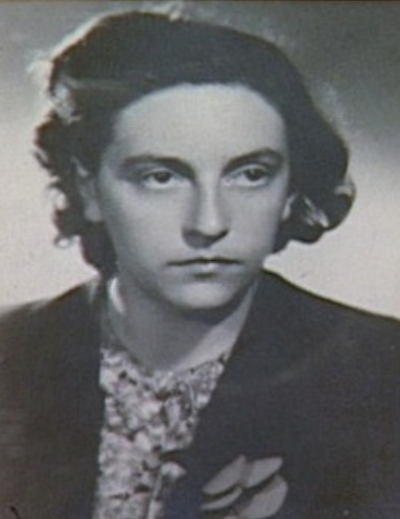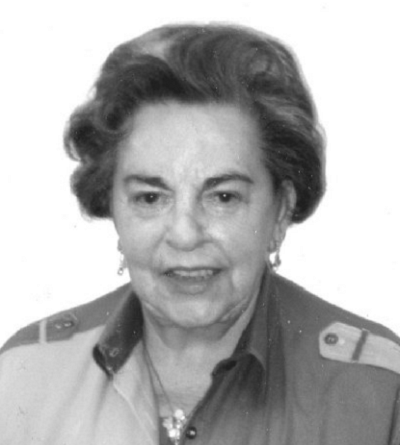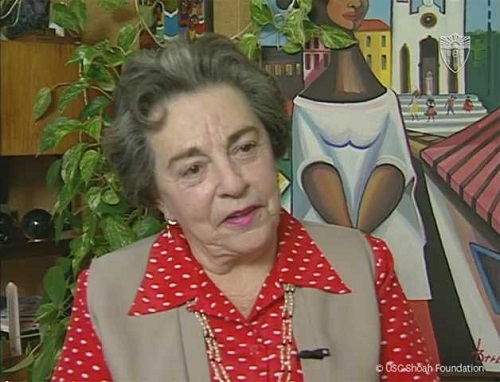Today we meet Věra Láska, the 15-year-old Czechoslovakian girl on the Nazi’s most wanted list. Incredibly, when she was just a teenager, Věra Oravcová defied the statistics and lasted three years as a Czechoslovak Resistance fighter (instead of the average six months). She survived Auschwitz and two other camps as a political prisoner and escaped the Nazis during a death march.

Věra Láska was born Věra Oravec (Věra Oravcová) on July 21, 1928, in Kosice, Czechoslovakia. Košice is a city in eastern Slovakia, close to the Hungarian border, which technically makes Věra a Slovak, though at the time of her resistance, she was a Czechoslovak. She grew up in a non-religious family.
It is often said that Americans who are born here never quite appreciate their history or their freedom as fully as those who adopt this country as their own. Well, nobody embodied that truth more fully than Věra Láska. While most of us, to use her words, “came to citizenship through happy coincidence”, she made a conscious decision to become an American.
—William Martin
Věra was not Jewish but went to an all-girls public school with many Jewish friends. This is because, before the Holocaust, Košice was home to one of the largest and most important Jewish communities in all of Czechoslovakia. In 1930, the city’s more than 11,500 Jews made up 16.4 % of the total population. The rich communal life of the Jews in Košice was destroyed between May 16th and June 5th of 1944, when almost all Jewish citizens of Košice were deported to Auschwitz.
Věra originally wanted to be a professional athlete and later dreamed of becoming a teacher. She recalled being angry and heartbroken when the German Army marched into her country a few months before World War II began.
Věra unwittingly joined the resistance when she and her friend Magda, both expert skiers, agreed to lead two men from Slovakia to Hungary who lacked proper identification papers. Over the next several years, Věra made about a dozen such trips, leading hundreds of political and Jewish refugees as part of an underground railroad from Slovakia to Hungary to Yugoslavia and beyond.
We “did it for fun” because it “gave me something to do.”
—Věra Láska
Věra and Magda escorted POWs and Jews across the border. Věra worked out of Czech Underground Headquarters in Budapest until her cover was blown. She was interrogated and put on a train to be brought to the police for ”supervised residency.” When changing trains, her guard allowed her to go to the ladies’ room, where she shed her coat, made an apron out of a scarf, grabbed a broom, and exited through a window.
In the spring 1943, Věra was arrested after being caught with false papers she had used during her trips across the border. After being jailed in her hometown for about a month, Věra was deported to Auschwitz II-Birkenau as a political prisoner. She arrived in Auschwitz the day her mother was gassed.
Refuse to feel powerless despite overwhelming adversity.
—Věra Láska
After arriving at Auschwitz-Birkenau in the early summer of 1943, Věra made friends with other women in the barracks. She recalled that they formed a “cooking club” where, although they were starving, they would gather to discuss food and recipes to sustain morale.
Relying on a theory that few people die on their birthdays, in 1944, on her birthday, Věra made the difficult decision to volunteer for an unknown assignment that would take her out of Auschwitz but might as easily result in her death. Along with some of her friends, Věra was transferred to work at a textile factory at Gross-Rosen. To impede production, Věra and other workers would participate in slowdown strikes and acts of sabotage when the guards were not looking.
I saw the German army march in to my country. And it was heartbreaking; it was very heartbreaking because all these ideals that we grew up with, freedom, truth shall prevail, all that went down the drain.
—Věra Láska
In early 1945, as the Soviet Army approached Gross-Rosen, the Nazis evacuated their prisoners to the concentration camp Dora-Mittelbau in central Germany. Věra then worked in a tunnel, measuring parts used in the German V-2 missile program. Her task was to divide the good rings from the bad, but she sabotaged the contents by arbitrarily dividing the parts.
In March 1945, this camp was evacuated, and the prisoners were forced on a death march to the Mauthausen concentration camp in Austria. Věra seized her chance to escape in a moment of confusion when hundreds of starving prisoners descended on a cauldron of soup. She fled into a nearby German barn miles away from Mittelbau-Dora where she hid for the next four days.
”We had wilder imaginations, including that of the possible dangers,” said Vera Laska, a member of the resistance movement in Czechoslovakia and an inmate at the Auschwitz, Gross Rosen and Dora Nordhausen camps. In the resistance, she recalled, ”I smuggled people from Poland to Slovakia, then to Hungary and Yugoslavia. Women were also used as cover: if a man was fleeing he was safer with a woman.”
—Věra Láska, New York Times
On the fifth day, a Ukrainian forced laborer who apparently knew of her hiding place came into the barn and told her to come down because the war was over. When she finally left the barn, American liberators were already in Europe and in the city she had been hiding in. She got food, water, and a medical checkup from the liberators. At 90 lbs, she was skin and bone.
Liberators took her to Prague, and she lived there for a few years and worked on investigating war criminals for the Czech War Crime Commission while also studying at the city’s Charles University. She gathered testimonies from war prisoners about SS soldiers to help make cases against them. She began to study history after that.
Women of many walks of life laid their lives on the line for freedom – whatever happened to them and to the thousands of their sisters whose names history no longer recalls?
—Věra Láska
In 1946, Věra’s professors at Charles University decided Věra should go to America to study American history, so Věra chose to attend the University of Chicago. Here, she met her future husband, Andrew J Láska, and the couple was married on November 5, 1949. They had a son, Thomas Vaclav Láska, in 1952 and later adopted a son, Paul Andrew Láska, from Costa Rica.
Věra continued her education and earned her doctorate in American history from the University of Chicago in 1959 and went on to be a professor and author of a number of books, including some about women and resistance during the Holocaust.

She became a professor of history at Regis College, enlightening her students on national history and Weston’s history.
Věra wrote some 350 articles, including her wonderful series on local history in the Weston Town Crier. She also wrote books on Ben Franklin’s life and the Founding Mothers’ lives and edited the acclaimed Women in the Resistance and in the Holocaust: The Voices of Eyewitnesses. She taught under Fulbright and George Washington Fellowships. She was one of the pillars of the historical society of Weston.

In fact, Věra Láska accomplished so much in her life that it is a wonder why more people do not know her name. Refusing to ever give up, she went on to accomplish the following:
- American history professor.
- Masaryk grantee, 1945-1946
- Institute International Education fellow, 1946-1947
- International House fellow, 1947-1949
- Foreign student counselor, University of Chicago, 1955-1959
- Consultant, Institute International Education, New York City, 1964-1966
- Consultant, evaluator Fulbright Commission, Sao Paulo, 1960-1964
- Professor of history, Regis College, Weston, Massachusetts, since 1966
- Named Outstanding Educator of America, 1972
- American History Association, 1984
- Recipient Kidger Award, 1984
- George Washington Honor Medal Freedoms Foundation of Valley Forge, 1990
- Fulbright professor Charles University, Prague, 1992-1993
- Lecturer in field
She earned a Master of Arts in History at Charles University in 1955 and a Doctor of Philosophy in History at the University of Chicago in 1959. She was also active in groups including the following:
- Chairman, Weston History Communications, 1972-1973
- Active Weston Bicentennial Committee, 1973-1976
- Massachusetts Bicentennial Commission, 1973-1977
- Trustee Weston Public Library., 1984-1985
- President Weston History Society, 1985-1988
- Member American History Association
- New England History Association
- New England History Teachers Association
- Czechoslovak Academy of Arts and Sciences in American
- American Association Foreign Student Affairs
- Masaryk Club
In the following video, over two hours long, Věra tells her story. We highly recommend you take the time and listen to this video about the remarkable story of this brave woman’s life.
At the time of Věra’s interview in 1996, she and her husband were living in Massachusetts.
Věra Láska passed away on December 11, 2005, in Newton, Massachusetts, after a long illness at the age of 82.
A movie is being made about Věra’s life. Previously named Vera, it is now known as Resistance. Listen to AOF-winning screenwriter Caitlin McCarthy discuss her new script.
You may wish to visit the website at Resistance the Movie.
Google Books also allows you to peek inside a few pages of books. In this case, we recommend that you peek into Women Reshaping Human Rights: How Extraordinary Activists Are Changing the World by Marguerite Guzman Bouvard. A direct link to the chapter on Vera Laska is here.
*Parts of this post originally appeared on the USC Shoah Foundation blog. There are several files there which offer a lesson and more information. We also sourced the Boston Globe obituary, Weston History memoriam, an article in the New York Times, a slideshow at Prezi, the book Women in European Holocaust Films: Perpetrators, Victims and Resisters, the Slovak Jewish Heritage Organization, and an article at Film Courage.
We tirelessly gather and curate valuable information that could take you hours, days, or even months to find elsewhere. Our mission is to simplify your access to the best of our heritage. If you appreciate our efforts, please consider donating to support this site’s operational costs.
See My Exclusive Content and Follow Me on Patreon
You can also send cash, checks, money orders, or support by buying Kytka’s books.
Your contribution sustains us and allows us to continue sharing our rich cultural heritage.
Remember, your donations are our lifeline.
If you haven’t already, subscribe to TresBohemes.com below to receive our newsletter directly in your inbox and never miss out.

















What a brave young girl and an inspirational woman. Kudos for bringing her story and life to our attention and awareness.